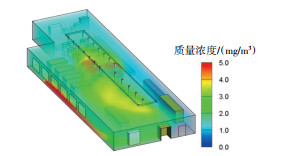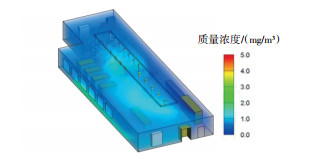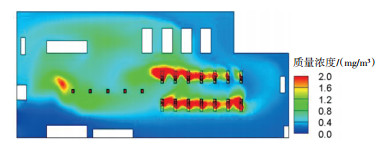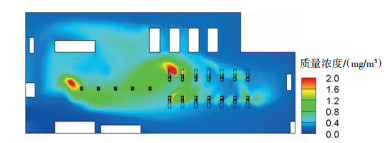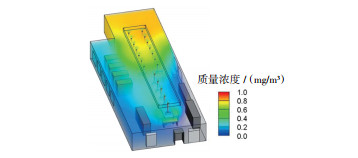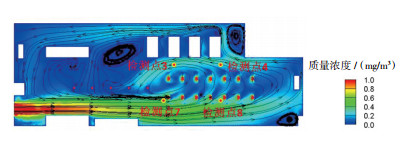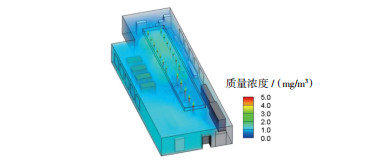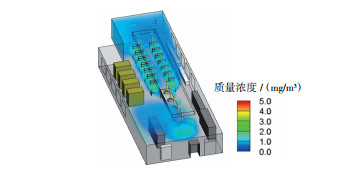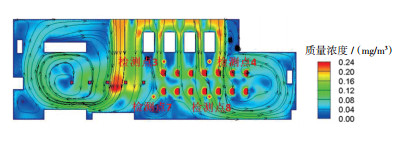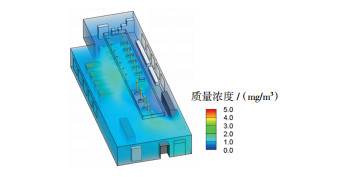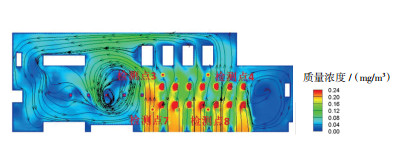Application of FLUENT in simulation of diffusion of airborne cyclohexanone in screen-printing process
-
+ English摘要:目的
了解丝网印刷作业中多个化学危害源共同作用下的环己酮弥散规律与控制特性。
方法利用FLUENT软件对丝网印刷作业环境中环己酮的弥散过程进行数值模拟,根据监测结果和计算结果讨论丝网印刷作业环境中毒物浓度的空间分布特点,研究通风口位置、入风口风速、入风口面积、障碍物存在对环己酮弥散的影响。
结果化学危害物浓度场可视性地揭示出化学危害物在墙壁周围和化学危害源附近容易集聚。基于不同入风口风速、不同入风口截面积、不同送风形式的化学危害物浓度模拟结果显示:(1)入风口风速为0.8 m/s时的车间内化学危害物浓度低于入风口风速为0.2 m/s时,表明入风口风速是化学危害物弥散的重要控制因素之一;(2)入风口截面积增大后,车间内气流组织形式发生变化,直接影响到气流流动速度场的改变,导致化学危害物浓度稀释而使得浓度场发生较大变化,表明入风口截面积大小同样是化学危害物弥散的重要因素之一;(3)不同的送风形式(左侧窗户或右侧窗户送风)形成的气流组织不尽相同,当气流自化学危害源上风向进入时,有利于车间内化学危害物随着气流经印刷机上方排风罩排出。
结论利用FLUENT仿真计算进行丝网印刷作业过程中环己酮弥散分析,可以可视性地揭示化学危害物在三维空间中的分布形态和集聚规律,有利于职业病危害因素的监测和防范。
-
传统的丝网印刷作业现场职业病危害评价,多采用现场调查法、检查表法、检测检验法与作业工人职业性健康检查相结合的方法。这种评价方法的评价参数虽然是定量和定性的,但也是非动态的。而丝网印刷作业现场室内空气流动的浓度场和速度场是以时间为变量的函数。本文拟通过丝网印刷作业现场工艺调查,以及对作业环境中毒物浓度空间分布的监测,并利用FLUENT流体工程仿真计算技术建立三维空间内毒物弥散数学模型,以研究通风口位置、入风口风速、入风口面积等对毒物弥散的影响,为丝网印刷作业毒物的职业危害评价与控制技术提供支持。FLUENT软件是一款强大的流体动力学软件,其数值模拟技术能够精确模拟日常遇到的各种流体的流动状态。
1. 对象与方法
1.1 对象
本次研究数据来自一个从事专项丝网印刷的车间。该车间总建筑面积为283 m2,计有14台印刷机,先后分别有5台、14台处于运行状态,成为作业场所污染源(见图 1)。每一操作人员负责一台印刷机。每一台印刷机工作时,作为一个污染源释放出污染物质的同时,各污染源之间发生着交互和影响作用。丝网印刷生产工艺流程中产生的危害因素主要有环己酮等。本文设定环己酮为职业病危害因素。
1.2 方法
对日常作业印刷机释放出的毒物环己酮进行现场检测,并对相应采集点的浓度数据进行数值模拟,通过求解环己酮弥散微分方程,建立起表征丝网印刷车间毒物(环己酮)弥散的数值计算模型。通过计算多个达到稳态的危害源连续释放毒物(环己酮)在作业场所任意一点的浓度值,预测危害物弥散后形成的浓度分布。
1.2.1 计算流体动力学(computational fluid dynamics,CFD)理论基础[1-4]
从环己酮在气体中基本弥散规律入手,结合前人的气体弥散理论和实验研究成果,采用FLUENT流体工程仿真计算中基于重整化群(re-normalization group,RNG)k-ε湍流模型及N-S方程组,计算丝网印刷作业空间内环己酮弥散数学模型。
1.2.2 气流组织评价指标的选择
(1)丝网印刷过程中环己酮弥散特点。受作业场所空间建筑结构的复杂性、室内空间气流组织、各种热源释放热量以及人员活动等因素的作用,毒物的弥散呈现复杂的弥散特征。(2)丝网印刷过程中环己酮弥散控制的评价指标。选择气流组织均匀性(不均匀系数)、能量利用系数、换气效率、危害物排除有效性(排污效率)作为评价指标。
1.2.3 毒物弥散规律与控制特性数值模拟
(1)数学物理模型的建立。①送风形式:研究送风形式时,考虑送风速度、送风角度、送风高度和综合因素对车间气流分布的影响。②网络生成:网格是离散的基础,网格节点是离散化物理量的存储位置。网格的形式和密度等,对数值计算结果有着重要的影响。
(2)Fluent计算参数设置。①网格的划分:在保证得到合适的网格前提下,同时充分考虑丝网印刷车间内部结构的复杂程度,采用非结构化网格进行划分。②紊流模型的选择及方程离散:紊流数值模拟采用标准κ-ε两方程模型,并应用Boussinesq假设。数值方程的离散采用有限容积法。③收敛标准的确定:能量方程的残差小于10-6,辐射方程的残差小于10-5,连续性方程、各速度分量、κ、ε的残差小于10-3。同时,使各计算残差曲线都趋于水平,以保证各参数值的稳定性。④边界条件和参数的设定:选取的边界条件有流动入口边界、流动出口边界、化学危害物模型选取、固壁边界等。在确保计算精度的前提下,对其进行一系列的假设。⑤初始条件的设置:非稳态问题初始条件,即为已知时间t=0时刻的变量。
(3)计算流体动力学模拟内容及结果可视化。①模拟内容:是基于多个化学危害源共同作用下的环己酮弥散规律与控制特性数值模拟。环己酮弥散控制特性数值模拟是基于不同入风口风速“站姿”呼吸带化学危害物浓度场数值模拟,研究气流(不同入风口风速和入风口大小)对化学危害物浓度场的影响,以及送风形式对车间气流的影响。②结果可视化:将数据库中每一个数据项作为单个图元元素表示。大量数据集构成数据图像,同时,将数据的各个属性值以多维数据的形式表示。
1.2.4 环己酮弥散模型与控制特性数值模拟应用
(1)计算参数设置。①模型构建:丝网印刷车间三维几何模型及二维简图见图 1。在确保计算精度的前提下,对物理模型再进行一系列合理的技术性简化,以提高计算机的计算速度。为了简化化学危害源模型,假设工作台1、各货架为化学危害源。现场检测时,车间内的14台印刷机处于运行状态。化学危害源之间的交互和影响作用,是模型建立不可避免的考虑因素。②模型网格划分:生成的网格数量确定为360万。③参数及边界条件设定:样品按照《工作场所空气中有害物质监测的采样规范》(GBZ 159-2004)[5]采集,按照《工作场所空气有毒物质测定脂环酮和芳香酮类化合物》(GBZ/T 160.56-2004)[6]分析。现场检测所得的工作环境:天气状况晴,室外温度25.2 ℃,空气湿度42.1%,风向西南,风速0.8 m/s;检测时,车间的平均温度为25.0 ℃,平均湿度为46.8%,平均气压为100.9 kPa。
1.2.5 仿真计算工具
使用FLUENT软件建立毒物弥散数学模型,并对结果进行分析。该软件利用数值方法模拟一个流场,包括划分网格、选择计算方法、选择物理模型、设定边界条件、设定材料属性,并对计算结果进行后处理。
2. 结果与分析
2.1 环己酮弥散模型数值模拟结果
2.1.1 置换通风方式条件下化学危害物速度场特征
该丝网印刷车间不开启空调,采用自然通风送风方式。化学危害物易在化学危害源附近形成涡流,分布在化学危害源两侧的涡流展现得尤为明显。化学危害源附近的气流形成大尺度涡流,并通过印刷机的排风罩的排风口排出车间,揭示出该处空气流场的流速比较高的特点。
2.1.2 置换通风方式条件下化学危害物浓度场特征
由图 2、图 3结合图 1可见,丝网印刷车间内来自化学危害源(工作台和货架,标志见图 1)的化学危害物向周围空气介质弥散过程中,随着通风时间的增加,其浓度降低。
2.1.3 模拟结果验证
由图 1和表 1可见,围绕工作台的检测点均能在不同时间段检测到环己酮,表明站姿呼吸带环己酮浓度场呈环状分布特征;除了个别检测点存在测量误差外,在印刷机处于工作状态后一定时间长度的测量值和模拟值之间的浓度变化趋势比较一致,表明所建立的物理模型比较合理、网格生成符合实际情况,能够得到稳定且有物理意义的收敛解。这里的检测时间是指在印刷机处于工作状态后的一定时间长度,即印刷机工作后15 min、30 min等。
表 1 站姿截面各检测点环己酮测量值与模拟值的对比(mg/m3) 检测时间 数值类别 点1 点2 点3 点4 点5 点6 点7 点8 点9 点10 15 min 测量值 < 0.33 < 0.33 5.28 1.44 < 0.33 3.67 1.51 3.49 1.82 1.29 模拟值 0.21 0.28 5.24 1.50 0.28 3.64 1.49 3.51 1.83 1.32 30 min 测量值 < 0.33 < 0.33 6.98 2.21 < 0.33 1.67 1.79 < 0.33 2.20 2.48 模拟值 0.15 0.31 7.02 2.19 0.29 1.71 1.75 0.24 2.18 2.45 45 min 测量值模拟值 < 0.33 0.18 < 0.33 0.16 4.03 4.10 2.32 2.29 < 0.33 0.23 < 0.33 0.15 < 0.33 0.27 < 0.33 0.19 < 0.33 0.13 < 0.33 0.08 60 min 测量值 < 0.33 < 0.33 3.10 4.91 < 0.33 < 0.33 1.98 5.1 1.85 2.52 模拟值 0.12 0.11 3.21 5.01 0.18 0.14 1.96 5.12 1.78 2.54 综上,可以认为丝网印刷车间内的原始气流组织处于相对稳定状态,但是,操作人员的随时走动会对气流组织造成影响,化学危害物也就随之产生扰动和弥散而导致浓度的无序弥散。对丝网印刷车间物理模型进行适当、合理的简化以及理想化处理,在一定程度上也会影响气流组织的形态而改变化学危害物浓度弥散特点。在误差允许范围内,利用FLUENT软件通过模拟值反映丝网印刷车间内化学危害物浓度特征,表征其空间分布和浓度变化是可行的。
2.2 环己酮弥散控制特征数值模拟
2.2.1 入风口风速对车间化学危害物浓度场的影响
该车间没有补(送)风系统。其门平时不常开,本次研究中处于开启状态。以门(高2.0 m、宽1.5 m)作为入风口,印刷机的排风罩为排风口,周边墙壁设置的窗户均予以关闭。由图 1和图 4可见,入风口风速为0.2 m/s时,在室内空气气流作用下,化学危害源正上方的化学危害物浓度高于化学危害源周围,并在水平方向上呈现多峰现象。实验[7]认为,各点化学危害物浓度会随时间递增而加大,多峰现象变得更加明显,谓其多化学危害源共同作用的化学危害物叠加。由图 1和图 5可见,入风口风速为0.8 m/s时,在室内空气气流长时间作用下,化学危害源正上方的化学危害物浓度高于化学危害源周围。对比图 4可以发现,随着入风口风速的提高,环己酮浓度场发生变化,化学危害源正上方的化学危害物浓度降低且规模也变小。研究表明,当送风速度很大时,在化学危害源附近形成的涡流强烈,使气流与周围空气的混合弥散作用增强;同时,随着送风速度的增加,化学危害物浓度分布的高度也随之增加。
2.2.2 入风口大小对车间气流及化学危害物浓度场的影响
由图 6可见,送风在未遇到障碍物前,衰减速度比较平缓,但是,当遇到障碍物之后,衰减速度就会加快,表明障碍物对置换通风气流组织在水平方向上的射流影响较大。由于壁面的影响,在靠近壁面和墙脚处(图 6中橙色处),气流受到阻挡可能会形成涡流,化学危害物在该处聚集导致浓度升高。
由图 7结合图 1可见,站姿呼吸带横截面速度流线图展示气流进入车间后,速度均匀衰减,遇到壁面等障碍物后向检测点4、检测点3所在过道回流,而且在两翼形成涡流。
依然以该门作为入风口,设置风速为0.2 m/s,印刷机的排风罩为排风口,周边墙壁设置的窗户均予以关闭,但改变门的高度(2.5 m)。由图 8可见,由于加大了门的高度,使得入风口的送风量增大。由于气流主体上沿着壁面流动且速度衰减依然平缓,较少在其他障碍物之间流动。这种气流组织的气流流动样式,使得车间内化学危害物浓度场分布特征与图 6不同,除化学危害源周围外,化学危害物主要聚集在门边的墙角处。
由图 9结合图 1可见,站姿呼吸带横截面速度流线图展示气流进入车间后,速度逐渐衰减,如同图 7,遇到壁面后分别向检测点4、检测点3所在过道和壁面回流,且于检测点(3、4)与壁面、检测点(7、8)与壁面之间形成涡流。
2.2.3 送风形式对车间气流及化学危害物浓度场的影响
开启左侧窗户(高1.2 m,宽1.0 m)作为入风口,风速0.2 m/s,门和右侧窗户均关闭。由图 10可见,气流自入风口进入车间后,由于受障碍物和壁面的阻挡,呈稳态向两翼形成大型涡流。最终,气流从印刷机排风罩排出。两侧自然补风的风流,有利于化学危害物有组织地经排风系统排出。气流流动过程中,由于出口流速较大,使得化学危害源附近产生负压,导致很大一部分化学危害物进入负压区,造成该区域的浓度不断增大。随着高度的增加,射流作用逐渐减弱,出口速度也随之减小,危害物不再滞留在化学危害源周围,浓度也逐渐减低。
由图 11可见,气流从左侧窗户进入车间后,与化学危害源弥散出的气体混合,在不同的部位有着不同的展示特征:受左侧窗户气流径直进入态势影响,站姿呼吸带横截面速度流线图展示出气流速度由高逐渐降低,且在窗户两翼沿壁面形成大型涡流。
开启右侧窗户(高1.2 m,宽1.0 m)作为入风口,风速也同前为0.2 m/s,门和左侧窗户均关闭。由图 12可见,气流自入风口进入车间后,一方面向着左侧窗户前障碍物流动,另一方面向着临门侧两翼障碍物之间流动并形成大型涡流。流动过程中,气流的速度逐渐降低,最终,又在印刷机排风罩处急剧提速。由于印刷机排风罩出口处流速较大,产生的负压使得气流流动时混入周围空气的化学危害物,除在窗户对面和临门侧大面积聚集外,通过出口大量向外排出。
由图 13可见,气流从右侧窗户进入车间后,与来自化学危害源的气体混合,在不同的部位有着不同于左侧送风的展示特征:左侧送风时,气流进入车间后沿壁面和障碍物形成不同级次的涡流;右侧送风时,速度流线图特征展示出紊乱状流场,局部见有小型涡流。气流或沿壁面呈稳态流动,或受障碍物阻挡呈涡流状流动,过程中速度逐渐减小。
3. 讨论
环己酮(C6H10O)作为重要的工业溶剂,在丝网印刷中用途广泛且用量较大,故本次研究选取环己酮作为研究对象。其为无色或浅黄色透明液体,有强烈的刺激性。易燃,遇高热、明火有燃烧的危险,与氧化剂接触剧烈反应。
环己酮具有麻醉和刺激作用,中毒者主要表现有眼、鼻、喉黏膜刺激症状和头晕、胸闷、全身无力等症状,重者可出现休克、昏迷、四肢抽搐、肺水肿,最后因呼吸衰竭而死亡,脱离接触后能较快恢复正常。
本次研究采取不同入风口风速、入风口截面积进行环己酮浓度数值模拟,研究这些参数对室内气流场的影响及其对环己酮浓度场的影响。送风量的大小取决于送风速度和送风口的大小,因此,送风速度和送风口大小对置换通风的影响,实质上就是送风量的影响。送风量的变化对置换通风车间室内气流会产生显著影响。随着送风量的增加,在提高了置换能力的同时,也改变了室内气流的空间分布样式。
基于不同入风口风速、不同入风口截面积、不同送风形式的化学危害物浓度模拟结果显示:(1)入风口风速为0.8 m/s时的车间内化学危害物浓度场背景低于入风口风速为0.2 m/s状况时(见图 4、图 5),表明入风口风速是化学危害物弥散的重要控制因素之一。(2)入风口截面积增大后,车间内气流组织形式发生变化,直接影响到气流流动速度场的改变,导致化学危害物浓度稀释而使得浓度场发生较大变化(见图 6—9),表明入风口截面积大小同样是化学危害物弥散的重要控制因素之一。提示入风口截面积不宜过小。(3)不同的送风形式(左侧窗户或右侧窗户送风)形成的气流组织不尽相同(图 11、图 13)。当气流自化学危害源上方进入时,有利于车间内化学危害物随着气流经印刷机上方排风罩排出。因此,来自于作业人员背侧的补风,能使得化学危害物更容易往呼吸带前方驱离,化学危害物浓度稀释使浓度场趋于低浓度背景,减少被作业人员吸入的可能性。
化学有害物浓度场可视性地揭示出化学危害物在墙壁周围和化学危害源附近容易集聚(见图 6、图 8),当丝网印刷从业人员活动区域化学有害物浓度超过允许范围时,会对人体健康产生危害。因此,对该重点区域设置合理有效的局部排风设施是极其重要的职业病预防控制措施。研究[8]表明,存在多个化学危害源时,一定区域弥散化学危害物浓度值高于单化学危害源,各化学危害源化学危害物对其他化学危害源化学危害物浓度弥散起着阻碍作用,上升气流将这部分化学危害物携带至其上部排风口。一旦排风设施抽排风失效(停电、故障等),由于弥散速度与浓度差有关,即浓度差越大弥散速度越大,故会使危害物聚集。因此,当化学危害源总弥散浓度保持不变时,化学危害源数量越多,车间内化学危害物浓度分布越大,越严重影响空气品质。做好日常防护设施的运行维护,是职业病预防控制的基础措施。
丝网印刷车间作业化学危害物弥散规律与控制特性研究,实际上是一种高大空间建筑条件下的室内空气品质研究,涉及许多影响因素。本次研究仅对一种自然气流组织形式进行模拟研究,尚未拓展到其他空调气流组织形式。排风口和送风口的数量、距离污染源的位置、尺寸及送风量等都是车间内污染物浓度的影响因素,为了更好地评估丝网印刷车间空气品质,改善车间内环境质量,有必要就这些参数继续进行模拟验证。目前,本次研究中采用的化学危害物计算模型多是根据经验公式、文献提供或给定一个假设条件获得,与真实情况还是有差异的。为了更加准确地评估丝网印刷车间化学危害物散发特点和浓度变化特征,还需要进一步对化学危害物散发模型进行深入研究。
-
表 1 站姿截面各检测点环己酮测量值与模拟值的对比
(mg/m3) 检测时间 数值类别 点1 点2 点3 点4 点5 点6 点7 点8 点9 点10 15 min 测量值 < 0.33 < 0.33 5.28 1.44 < 0.33 3.67 1.51 3.49 1.82 1.29 模拟值 0.21 0.28 5.24 1.50 0.28 3.64 1.49 3.51 1.83 1.32 30 min 测量值 < 0.33 < 0.33 6.98 2.21 < 0.33 1.67 1.79 < 0.33 2.20 2.48 模拟值 0.15 0.31 7.02 2.19 0.29 1.71 1.75 0.24 2.18 2.45 45 min 测量值模拟值 < 0.33 0.18 < 0.33 0.16 4.03 4.10 2.32 2.29 < 0.33 0.23 < 0.33 0.15 < 0.33 0.27 < 0.33 0.19 < 0.33 0.13 < 0.33 0.08 60 min 测量值 < 0.33 < 0.33 3.10 4.91 < 0.33 < 0.33 1.98 5.1 1.85 2.52 模拟值 0.12 0.11 3.21 5.01 0.18 0.14 1.96 5.12 1.78 2.54 -
[1] 何艳丽.空间结构风工程[M].上海:上海交通大学出版社, 2012. [2] 宋鹏云, 焦凤, 朱孝钦, 等.过程流体力学[M].北京:化学工业出版社, 2016. [3] 朱红均, 林元华, 谢龙汉. FLUENT流体分析及仿真使用教程[M].北京:人民邮电出版社, 2010. [4] 张师帅.计算流体力学及其应用——CFD软件的原理与应用[M].武汉:华中科技大学出版社, 2011. [5] 中华人民共和国卫生部.工作场所空气中有害物质监测的采样规范: GBZ 159-2004[S].北京: 人民卫生出版社, 2006. [6] 中华人民共和国卫生部.工作场所空气有毒物质测定脂环酮和芳香酮类化合物: GBZ/T 160.56-2004[S].北京: 人民卫生出版社, 2004. [7] 刘波.多污染源共同作用对工业建筑室内污染物浓度分布的影响[D].西安: 西安建筑科技大学, 2015. http://cdmd.cnki.com.cn/Article/CDMD-10703-1015994497.htm [8] 孙斌, 韩克, 蒋能飞.污染源位置对气体污染物影响的数值模拟[J].环境科学与技术, 2012, 35(2):114-117. doi: 10.3969/j.issn.1003-6504.2012.02.024 -
期刊类型引用(2)
1. 崔西勇,尹峰,和贵山,郑昀,潘兴富. 某实验室乙炔泄漏扩散过程的数值模拟分析及管理措施优化. 职业卫生与应急救援. 2024(06): 788-793 .  本站查看
本站查看
2. 张宏远,李晨. 风速和泄漏速率对碳酰氯泄漏扩散危害空间的影响. 职业卫生与应急救援. 2022(01): 10-15+31 .  本站查看
本站查看
其他类型引用(1)






 下载:
下载:
